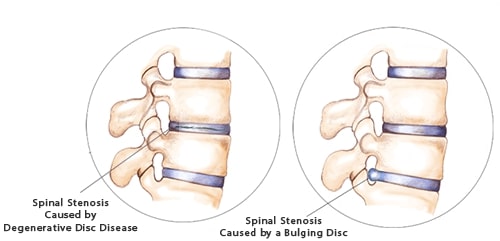
In the medical field, stenosis means the abnormal narrowing of a body channel. When combined with the word spinal, it defines a narrowing of the bone channel occupied by the spinal nerves or the spinal cord.
Some people are born with a congenital form, but most develop spinal stenosis as part of the degenerative cascade. A few do not feel any effects of the narrowing, but as part of the aging process, most people will eventually notice radiating pain, weakness, and/or numbness secondary to the compression of the nerves or spinal cord.
While the narrowing may occur at different parts of the spine, the symptoms of nerve compression are often similar. That is why specialists often will perform testing to determine the cause and location of the narrowing.
Lumbar vs. Cervical Stenosis
The lower back develops lumbar stenosis, while the neck develops cervical stenosis.
- Lumbar Spinal Stenosis: In lumbar stenosis, the spinal nerve roots in the lower back become compressed and this can produce symptoms of sciatica—tingling, weakness or numbness that radiates from the low back and into the buttocks and legs—especially with activity.
Lumbar spinal stenosis often mimics symptoms of vascular insufficiency. Both conditions can cause claudication, which means leg pain with walking. If vascular studies identify normal blood flow, and there is confirmation of spinal stenosis on diagnostic testing, the symptoms are then called neurogenic claudication. In the classic description, people with spinal stenosis will describe the onset of leg pain, or weakness with walking, but with relief of symptoms with sitting. Many will also describe increased tolerance for walking when flexed forward, such as when walking while leaning forward on a shopping cart.
While lumbar spinal stenosis most often occurs at the L4-L5 and L3-L4levels, it can occur at any level in the spine. The degenerative cascade may eventually affect most of the vertebral segments of the lumbar spine.
- Cervical Stenosis
Spinal stenosis pain in the neck is called cervical spinal stenosis. This condition means that there is potential compression of the spinal cord. Unfortunately, the spinal cord compression can lead to serious problems such as extreme weakness, or even paralysis. With cervical stenosis, anyone who develops signs of spinal cord compression (myelopathy) may need more invasive treatment, such as surgery.
Thoracic stenosis can also occur but is less common. The thoracic part of the spine is the middle/upper portion of the spine and mainly consists of the vertebrae that are attached to the rib cage. This stable and strong part of the spine allows for minimal movement, which is why degenerative conditions such as spinal stenosis are less likely to develop.
Spinal Stenosis and the Aging Spine
Spinal stenosis is related to degeneration in the spine and usually will become significant in the 5th decade of life and extend throughout every subsequent age group. As it is a gradual process and rarely causes immediate symptoms, the subtle changes of spinal stenosis often result in a gradual decrease in physical activity, and development of a more kyphotic or forward flexed posture.
This gradual accommodation may be evident when looking at a series of oneself in pictures over the course of several years after around age 50. It is typical to start stooping forward more and become less active as effects of spinal stenosis increase.
If you are suffering from pain, please contact our office at (516) 419-4480 or (718) 215-1888 to arrange an appointment with our Interventional Pain Management Specialist, Dr. Jeffrey Chacko.













